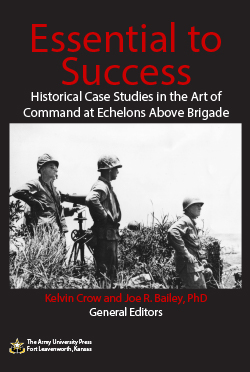
Download the PDF 
Historical Case Studies in the Art of Command at Echelons Above Brigade
By Kelvin Crow and Joe R. Bailey, PhD
372 Pages
Published: 2017
Essential to Success: Historical Case Studies in the Art of Command at Echelons Above Brigade was commissioned as a companion to the Army’s 2017 version of FM 3-0, Operations. It contains twenty engaging and thought-provoking chapters by scholars and former large unit commanders who analyze key decisions, enabling factors, and limiting factors in large unit combat operations from the Second World War to current conflicts. Each section begins with a history of the division, corps, or army followed by chapters presenting actions at that level famous and obscure, successful or not.
The U.S. Army’s recent history of small-unit operations, combined with increased potential for large-scale combat against peer or near-peer rivals and advances in technology and social media call for a reassessment of command at senior levels. Essential to Success highlights situations faced by commanders of the past, explains and contextualizes the problems they faced, the decisions they made, and the outcomes of those decisions. The book invites readers, commanders, and their staffs to think critically and apply historical experience to large-scale ground combat of the future in an attempt to preserve American lives and valuable national resources.